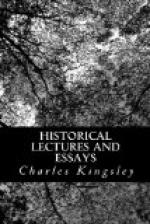He did not recover his sight, seemingly on account of the erysipelas, for a week more. He then opened his eyes upon the miraculous image of Atocha, and vowed that, if he recovered, he would give to the Virgin, at four different shrines in Spain, gold plate of four times his weight; and silver plate of seven times his weight, when he should rise from his couch. So on the 6th of June he rose, and was weighed in a fur coat and a robe of damask, and his weight was three arrobas and one pound—seventy-six pounds in all. On the 14th of June he went to visit his father at the episcopal palace; then to all the churches and shrines in Alcala, and of course to that of Fray Diego, whose body it is said he contemplated for some time with edifying devotion. The next year saw Fray Diego canonised as a saint, at the intercession of Philip and his son; and thus Don Carlos re-entered the world, to be a terror and a torment to all around him, and to die—not by Philip’s cruelty, as his enemies reported too hastily indeed, yet excusably, for they knew him to be capable of any wickedness—but simply of constitutional insanity.
And now let us go back to the history of “that most learned, famous, and rare Baron Vesalius,” who had stood by and seen all these things done; and try if we cannot, after we have learned the history of his early life, guess at some of his probable meditations on this celebrated clinical case; and guess also how those meditations may have affected seriously the events of his afterlife.
Vesalius (as I said) was a Netherlander, born at Brussels in 1513 or 1514. His father and grandfather had been medical men of the highest standing in a profession which then, as now, was commonly hereditary. His real name was Wittag, an ancient family of Wesel, on the Rhine, from which town either he or his father adopted the name of Vesalius, according to the classicising fashion of those days. Young Vesalius was sent to college at Louvain, where he learned rapidly. At sixteen or seventeen he knew not only Latin, but Greek enough to correct the proofs of Galen, and Arabic enough to become acquainted with the works of the Mussulman physicians. He was a physicist too, and a mathematician, according to the knowledge of those times; but his passion—the study to which he was destined to devote his life—was anatomy.
Little or nothing (it must be understood) had been done in anatomy since the days of Galen of Pergamos, in the second century after Christ, and very little even by him. Dissection was all but forbidden among the ancients. The Egyptians, Herodotus tells us, used to pursue with stones and curses the embalmers as soon as they had performed their unpleasant office; and though Herophilus and Erasistratus are said to have dissected many subjects under the protection of Ptolemy Soter in Alexandria itself: yet the public feeling of the Greeks as well as of the Romans continued the same as that of the ancient Egyptians;




